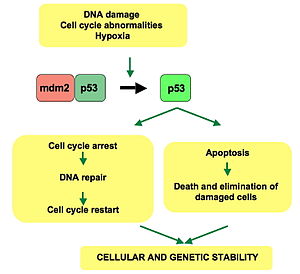p53
mammalian protein found in Homo sapiens
p53 (or tp53) is a gene vital to many forms of life, including humans. It codes for a protein which suppresses cancer. It has been called "the guardian of the genome".[1]

When DNA is damaged, the gene gets activated. Once activated, p53 stops the cell division cycle. Either repair of the cell or apoptosis occurs. How p53 makes this choice is not known
The p53 gene is the most frequently mutated gene (>50%) in human cancer.[2] Its protein product binds to DNA and regulates gene expression to prevent mutations of the genome.[3]
p53 protein (TP53) is at low levels in human embryonic stem cells (hESCs).[4] This allows the most important cell division to proceed rapidly.
References
change- ↑ Read AP, Strachan T (1999). "Chapter 18: Cancer genetics". Human molecular genetics 2. New York: Wiley. ISBN 0-471-33061-2.
- ↑ Surget S, Khoury MP, Bourdon JC (2013). "Uncovering the role of p53 splice variants in human malignancy: a clinical perspective". OncoTargets and Therapy. 7: 57–68. doi:10.2147/OTT.S53876. PMC 3872270. PMID 24379683.
- ↑ Arnold J. Levine; David P. Lane, eds. (2010). The p53 family : a subject collection from Cold Spring Harbor Perspectives in biology. Cold Spring Harbor, N.Y.: Cold Spring Harbor Laboratory Press. ISBN 978-0-87969-830-0.
- ↑ Jain AK, et al. (2012). "p53 regulates cell cycle and microRNAs to promote differentiation of human embryonic stem cells". PLOS Biology. 10 (2): e1001268. doi:10.1371/journal.pbio.1001268. PMC 3289600. PMID 22389628.